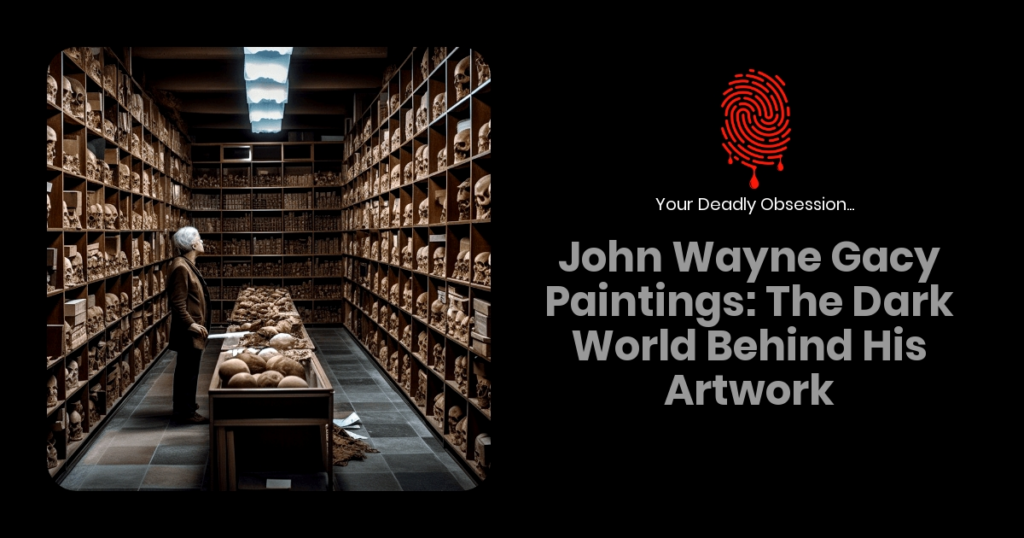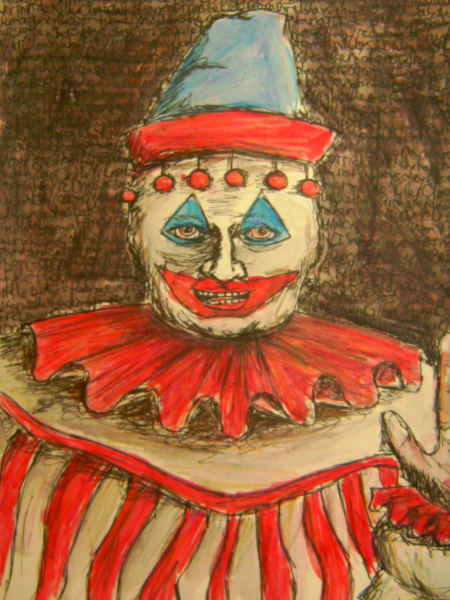When we think of infamous serial killer John Wayne Gacy, also known as the “Killer Clown,” art isn’t usually the first thing that comes to mind. However, Gacy’s paintings have become a disturbing yet unique chapter in the world of macabre collectibles, garnering fascination and controversy in equal measure. In this article, we’ll delve into the dark world of John Wayne Gacy’s paintings, examining the history, themes, and impact of these unsettling works.

Before his execution in 1994, Gacy spent much of his time on death row creating artwork, including self-portraits donning his “Pogo the Clown” persona, and various depictions of other famous personalities. These paintings were initially sold to help pay for his legal expenses, but eventually, they caught the eye of collectors and enthusiasts of true crime memorabilia. While some view these paintings as a horrific artifact from a malevolent figure, others regard them as a unique, thought-provoking exploration of the darkest depths of the human psyche.
Throughout this article, we will further explore the cultural significance of Gacy’s paintings and the various moral dilemmas they present. Can these works truly be considered art, or are they simply a repugnant reminder of one man’s heinous crimes? Despite the controversy surrounding Gacy’s artwork, there’s no denying its ability to captivate and provoke discussion on the complex relationship between art and the human experience.
The Life and Crimes of John Wayne Gacy
John Wayne Gacy, also known as the Killer Clown, was one of the most notorious serial killers in American history. We’ll take a closer look at his life, crimes, and the chilling artwork he created while awaiting execution.
Gacy was born in Chicago in 1942 and faced a troubled upbringing marked by physical abuse from his father. As he grew older, Gacy began to develop an interest in entertaining children, creating a clown persona named Pogo the Clown. He would perform at events, fundraisers, and children’s hospitals. While his clown persona convinced many that Gacy was a good-hearted man, it would later become a haunting symbol of his dark nature.
During the 1970s, Gacy pursued an active career in construction and politics, which allowed him further access to young men. His killing spree began in 1972 and spanned until 1978, claiming the lives of at least 33 young men and boys. Gacy’s method usually involved luring victims into his home, incapacitating them with a tangled rope trick, sexually assaulting them and eventually strangling them to death. He hid the majority of his victims’ bodies in a crawl space beneath his house.
| Year | Number of Victims |
|---|---|
| 1972 | 1 |
| 1973 | 1 |
| 1974 | 2 |
| 1975 | 9 |
| 1976 | 9 |
| 1977 | 6 |
| 1978 | 5 |
It wasn’t until December 1978 that authorities caught up with Gacy. They had been investigating the disappearance of 15-year-old Robert Piest, and Gacy inadvertently became the main suspect. After obtaining a search warrant and digging up Gacy’s home, 29 bodies were discovered, and four more were later found in nearby rivers.
Gacy was arrested and charged with 33 counts of murder. During his trial, he attempted to plead not guilty by reason of insanity, but the jury rejected this defense. In 1980, Gacy was found guilty and sentenced to death. While on death row, he took up painting as a way to pass the time. Many of his paintings featured his alter ego, Pogo the Clown, adding a macabre element to his artwork.
- His artwork featured:
- Pogo the Clown
- Skulls
- Disney characters
In 1994, Gacy was executed by lethal injection. His paintings have since become grim memorabilia for collectors, serving as a chilling reminder of the man’s crimes and dual nature.
Remember to visit MurderArchives.org for more articles on cold cases, crime, and mystery.
The Role of Artwork in Gacy’s Incarceration
During John Wayne Gacy’s incarceration, his artwork gained significant attention and remains a topic of interest in the true crime world. Gacy’s paintings offer insights into the notorious serial killer’s mind, allowing us to further understand his actions and motivations. In this section, we’ll delve into the role artwork played during his time in prison.
Gacy began creating art after his arrest and continued painting until his execution in 1994. Although he had no formal training, his paintings generated a considerable amount of controversy and fascination. Gacy’s subjects included famous pop culture icons, clowns— notably himself as Pogo the Clown— and his own criminal acts.
Art therapy programs were made available to Gacy during his imprisonment. Some experts believe that his paintings served as a form of self-expression, helping him cope with his confinement. Others suggest that his artwork was a calculated effort to maintain notoriety and manipulate public opinion.
Gacy’s art became a point of contention post-incarceration due to the commercialization of his work. Some of his paintings have been displayed in galleries, while others can be found in numerous online auctions. Collectors eagerly seek these controversial pieces, which has led to the emergence of a subculture focused on the acquisition of “murderabilia”.


There are opposing views on the ethical ramifications of collecting or selling art created by convicted felons. While some embrace the notion that the artwork is separate from its creator and serves as a reminder of his heinous crimes, others feel that it promotes the sensationalization of criminality and might even encourage copycat behavior.
To better illustrate the impact and influence of Gacy’s artwork, consider the following data from past auctions:
| Year | Auction | Number of Paintings Sold | Highest Selling Price |
|---|---|---|---|
| 1997 | Leslie Hindman Auctioneers | 15 | $6,000 |
| 2002 | Pickens-Kane Auctions | 20 | $7,500 |
| 2010 | Alexander Autographs | 18 | $9,000 |
Based on these auction results, it’s clear that John Wayne Gacy’s artwork had a significant impact during his incarceration and continues to hold an unsettling place in the public consciousness. It sparks debate around crime, notoriety, and ethics, and serves as a reminder of the chilling legacy left behind by one of America’s most notorious serial killers.
The Controversial Collectability of Gacy’s Paintings
When it comes to the world of true crime, few things spark more intense debate than the artwork of notorious serial killer John Wayne Gacy. Gacy’s paintings have become a controversial topic among collectors, with opinions sharply divided on whether these pieces should be considered valuable or not. We’re going to delve into the reasons behind the collectability of Gacy’s paintings and why they continue to captivate fans of cold cases, crime, and mystery.
Gacy’s paintings gained notoriety after his arrest in 1978, when he began creating art behind bars. Initially, these works were sold to raise funds for his legal defense. However, their popularity quickly grew among collectors and true crime enthusiasts. Some of the most famous Gacy paintings include portraits of clowns, such as Pogo the Clown, as well as images of historical figures, like Elvis Presley.
While some people are fascinated by the artwork created by a notorious criminal, others view them as a sickening reminder of his heinous crimes. Detractors argue that buying and selling Gacy’s paintings glorifies his actions and disrespects the memories of his victims. Despite these concerns, Gacy’s paintings have fetched high prices on the collectors’ market:
| Year | Painting | Price |
|---|---|---|
| 2011 | “Pogo the Clown” | $7,500 |
| 2017 | “I’m Pogo the Clown” | $14,000 |
The controversial nature of Gacy’s paintings has led to public protests and even the destruction of some of his works. In 1994, a group of his victims’ family members gathered to publicly burn more than 20 of his paintings. These actions, however, have only increased curiosity and demand for the remaining pieces of Gacy’s art.
Many collectors justify their interest in Gacy’s paintings by noting their historical significance. They argue that these artworks provide unique insights into the mind of a convicted serial killer, which can be valuable for researchers and psychologists studying criminal behavior. In this context, Gacy’s paintings can be likened to other historical artifacts related to infamous criminals, such as:
- Jack the Ripper’s letters
- Ted Bundy’s personal belongings
- Charles Manson’s music recordings
There’s no denying the controversy surrounding the collectability of John Wayne Gacy’s paintings. As long as true crime fans continue to find intrigue in the darkest corners of human behavior, the market for these macabre pieces is likely to remain strong. But one thing’s for sure: the debate over the ethics of buying and selling Gacy’s artwork will continue to rage on.
The Impact of Gacy’s Art on Serial Killer Memorabilia
When it comes to the world of serial killer memorabilia, John Wayne Gacy’s paintings have undeniably made a significant impact. As one of America’s most notorious serial killers, Gacy’s artwork has become synonymous with the macabre subculture of true crime enthusiasts.
Many collectors of Gacy’s art are captivated by the connection between the man behind the brush and the horrific crimes he committed. These paintings offer a chilling window into the mind of someone who was capable of such atrocities. Furthermore, Gacy’s artwork has started a wider trend of collecting serial killer artifacts, leading to a controversial business known as “murderabilia.
The fascination with Gacy’s artwork has reached a wide audience, with famous musicians and actors among the collectors. This has elevated Gacy’s paintings to an even greater level of notoriety. Prices for his paintings have reached astonishing levels, with some pieces selling for tens of thousands of dollars.
| Artwork Name | Year Sold | Price |
|---|---|---|
| Pogo the Clown | 2011 | $7,500 |
| Skull Clown | 2017 | $20,000 |
Collecting serial killer memorabilia, especially John Wayne Gacy’s paintings, has been met with widespread criticism. Many argue that there is an ethical line being crossed by profiting from such heinous acts. Despite these concerns, the murderabilia market continues to thrive.
Gacy’s art has also played a role in academic and psychological studies. Researchers have analyzed his paintings in an attempt to better understand the thought process of a serial killer. This research can potentially provide valuable insights into criminal minds and help create more effective preventive or rehabilitative strategies.
In conclusion, the impact of John Wayne Gacy’s paintings on the serial killer memorabilia market can’t be overstated:
- Gacy’s artwork has become a focal point for true crime collectors and murderabilia enthusiasts.
- High-profile collectors have elevated the notoriety of Gacy’s artwork.
- The sales of Gacy’s paintings have sparked controversy and ethical debates.
- Researchers are using Gacy’s paintings as a tool to better understand criminal minds.
While the market for Gacy’s art remains controversial, it’s clear that the legacy of his paintings will continue to shape the world of murderabilia and our understanding of serial killers.
Conclusion: The Fine Line Between Art and Infamy
It’s essential to consider the implications of John Wayne Gacy’s artwork and its connection to his heinous crimes. As fans of cold cases and mystery, we cannot deny the undeniable intrigue these paintings offer. However, we must also acknowledge the chilling aspect of Gacy’s art – it reflects the mind of a serial killer.
Throughout history, art and infamy have been linked. For instance:
- Adolf Hitler had aspirations of becoming an artist
- Charles Manson released an album of his own music
- Richard Ramirez, the Night Stalker, was a fan of heavy metal music, and his caricatures were subsequently published in magazines
Let’s dive deeper into the world of John Wayne Gacy’s art and explore the fine line between creativity and criminality.
Gacy’s art, produced during his time on death row, reflects a range of subjects:
- The Seven Dwarfs
- Disney characters
- His alter ego, Pogo the Clown
- Self-portraits
What’s alarming is the question: Should we appreciate and value art that’s created by someone responsible for so many deaths? It’s a debatable subject, and opinions vary.
Here are some arguments:
- Some argue that the art should be appreciated solely on its artistic merit. A collector may find interest in the artwork without condoning Gacy’s actions.
- Others believe that buying, selling, or displaying Gacy’s artwork glorifies a notorious serial killer and that the art should not be promoted in any way.
- Finally, there are people who see Gacy’s artwork as unique pieces of history related to one of the most infamous serial killers in American history, and they collect these pieces to preserve that dark history.
In conclusion, there’s no right or wrong answer when it comes to the debate surrounding John Wayne Gacy’s art. We, as mystery and crime enthusiasts, can’t help but find these paintings fascinating. However, we must tread cautiously when discussing art created by a person with such a horrifying past. Art and infamy will continue to cross paths throughout history, but as long as we’re aware of the moral implications, we’re in a better position to make informed decisions about our interest in such subjects.
References:
https://en.wikipedia.org/wiki/John_Wayne_Gacy

Owner & entrepreneur with a passion for murder mystery! Seriously, who doesn’t love murder mystery?
Chris is a proud member of the American Medical Writer’s Association (AMWA), the International Society for Medical Publication Professionals (ISMPP), the National Association of Science Writers (NASW), the Council of Science Editors, the Author’s Guild, and the Editorial Freelance Association (EFA).

